2011 Okinawa Trip
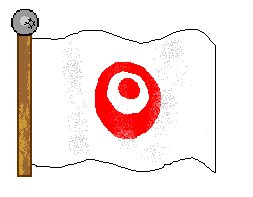
Every trip to Okinawa seems harder to remember. There is some haze that hangs over our memories, not induced by jet lag, interupted sleep patterns or long nights with the island's treasured Orion beer. I think that it is that our training and experiences become so overwhelmingly special that it is hard to find a point of reference for a particular thing to focus on. When asked about this trip, I found it hard to give everyone a straight answer about the experience and that it was "great."
I knew that the strained look on my face probably sent mixed signals to my students, family and friends but it was different than my former journeys to Okinawa. Not having to take students and do the Holy Trinity: Shuri Castle; Churaumi Aquarium; Shureido:, it was a trip where the experiences with our seniors and each other blended night with day and never seemed to stop.
|
|
|
|
Wednesday July 6th
We arrived at Richmond today with no problems and got checked in quickly with Continental. We saddled up to the nearest pub and had our traditional Bloody Marys that fires the starting pistol for every exciting trip to Okinawa. Maybe it is some surpressed adolescent ritual that we do to show ourselves that we are officially off the reservation, on vacation and can do whatever we want. Doesn't everyone like that feeling of liberation? For all of us, this trip is not only a training/cultural excursion but also a purging of the stressful schedules of our lives.
We arrived in Washington/Dulles Airport with no no problems-it was only a 25 minutes flight(you barely had time to get the laptop open before you had to turn it off again. We made it to the terminal just as they were starting to board and quickly got ourselves settled in. Like the fin of a shark, we started to see the heads of small children bob up and down in the seats in our section and that finger of worry began poking all of us.
|
 |
|
Thursday July 7th
As luck would have it, none of us slept very well and as all cultures are different, the parents of these children had different tolerances for behavior. The kids began very early on playing with each other, bouncing on seats while holding to the headrest in front of them, crying and just plain shouting the same words over and over like a broken talking doll. Needless to say, we needed more sleep aids but the flight attendants were sticking to the airlines "two alcoholic drinks per passenger." The flight was not fun. The only thing that saved Joe and I was laughing hysterically through the movie "Hall Pass" and a surprisingly decent hot turkey and cheese sandwich.
We arrived in Narita where we were pleasently surprised to be whisked through immigration and were able to get our bags with no problems as well. We had some time to kill so we went up to the observation deck, changed our clothes and got a small bite to eat.
|
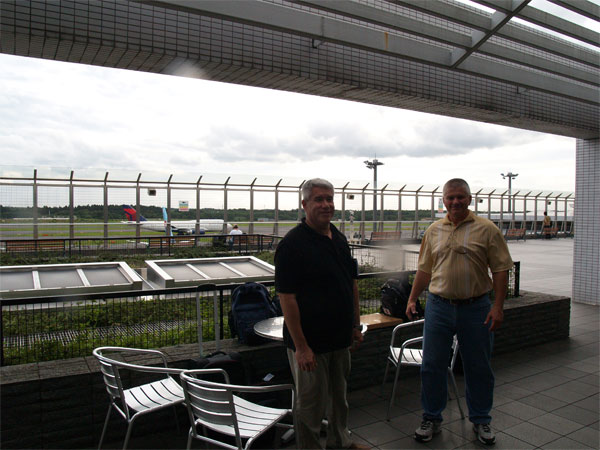 |
|

|
|
| We left for Okinawa with a hot plane cabin and a drained battery on my laptop. There was an unusual sunset outside my window that never seemed to end but was beautiful to watch. Dave succumbed to HCIF (Hyperactive Child Induced Fatigue) from the evil kids on the previous flight and we soon arrived at Naha Airport. This flight was packed with people, mostly our brave service men and women and as we made our way to baggage claim I didn't see anyone yet in the arrival terminal. |
 |
|
As it turned out, many of the Butokukan members came to meet us at the airport as well as my exchange student/daughter Rio Yamazato who had just lived with our family for a year. Makoto Gibu was teaching class at the hombu so that Gibu Sensei could meet us at the airport.
At that moment, it hit me. He always meets us at the airport, always. Such a busy man and yet he drops what he is doing, drives personally to airport to stay maybe 20 minutes to greet us and then goes home. I couldn't help reflect on how lucky I was, as I seem to do every day of my life. Not just in being the student of one of the most famous and senior teachers of his Nakazato-ha generation but to have him care about us in this way.
Gibu Sensei and I briefly asked about each of our families and the itinerary for the week as we started to make our way to the hotel bus that Izumi Sensei had borrowed. I gave Rio a suitcase of some of her things from her homestay with my family and then touched base about getting together as often as possible throughout the week.
|
 |
|
Left to Right: Izumi Sensei, Sunagawa Sensei, Gibu Sensei, John Spence, Dave Williams, Joe Wilson, Tamaki Sensei
|
|
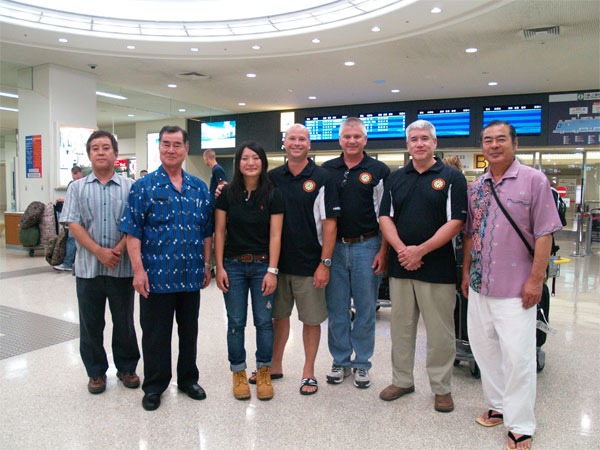 |
|
After quick goodbyes, we piled in the bus and headed up 58 to Koza. It was sad to see the Pizza House gone. Famed author Michael Clarke had told me about it's demise a few months ago however the memories of many kangeikai there will always remain.
We quickly checked into our room at the Deigo Hotel and then headed to our favorite izakaya, The Lemon Grass, with Izumi Sensei. We had a wonderful meal complete with ice cold Orion, goya champaru, chu ma gu(pig joints), pigs feet, somen champaru, yaki tori, and cold somen appetizer. It was great to catch up with Izumi Sensei and decompress from the travel.
We let Izumi Sensei go home since he had to work in the morning and we returned to the hotel for our tradition of hanging out on the rooftop, looking at the nighttime lights of Okinawa, a group performance of Naihanchi Shodan and a beer before succumbing to sleep in our room.
|
 |
|
|
 |
|
Friday July 8th
I woke up around eight after a restless sleep and started to unpack a bit and check emails. I headed up to the onsen(traditional Japanese bath) on the 5th floor and then joined the guys in the restaurant for breakfast. Joe and I left for Fuji-Rent a Car and pick up our sedan for the week. Joe very graciously handled the driving this trip-we normally split duties on other trips since we usually have a group and two vehicles. We stopped at the 100 yen store to buy wrapping paper and bags for the gifts we brought and also to get some supplies for our fridge for the week.
|
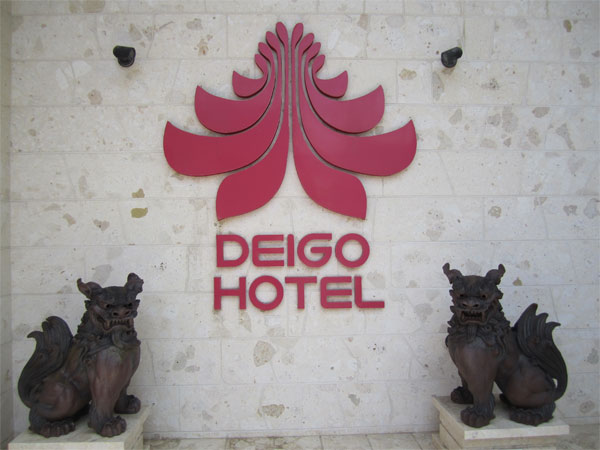 |
|
|
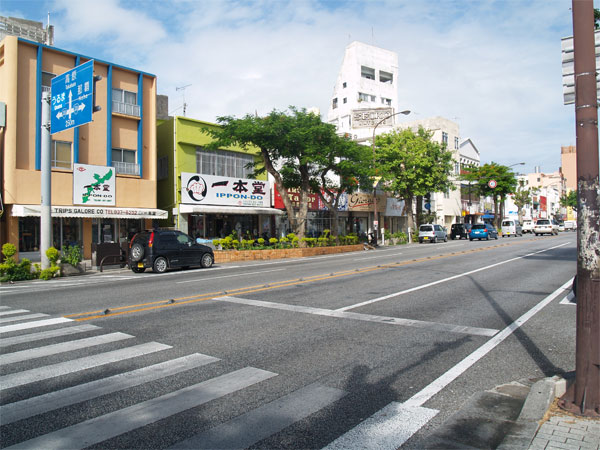
Morning on Gate 2 Street
|
|
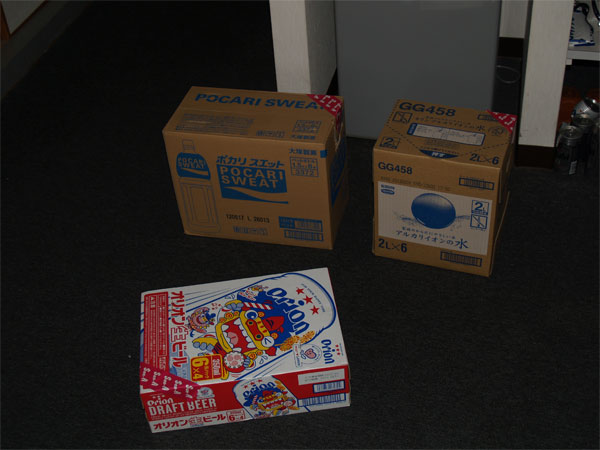
Essentials for Okinawa survival training
|
|
We picked up Izumi Sensei at his house and drove to Shureido where we going to meet Rio. This was not a scheduled trip to the famous martial arts supplier but rushing out of the house for the airport, I forgot to take my gi out of the dryer and left it at home. Joe bought a bo to keep at the Hombu Dojo for future trips, I bought a New Wave Kumite Gi(which is fantastic if you are looking for a new gi) and we forced Dave to buy a baseball bat for his first shin break later on the trip.
Rio showed up on the back of a scooter and she and Izumi Sensei discussed a place to go have lunch. We ended up a nice restaurant near Toyomi Bridge in Naha and had a great lunch of Okinawa Soba and Soki Soba. I tried to pay the bill but Izumi Sensei headed me off and after a minute of friendly arguing, he pulled the sempai rule on me and I had to forfeit. We drove Rio to Shuri Station near her home told her that we would catch up on Sunday.
|
 |
 |
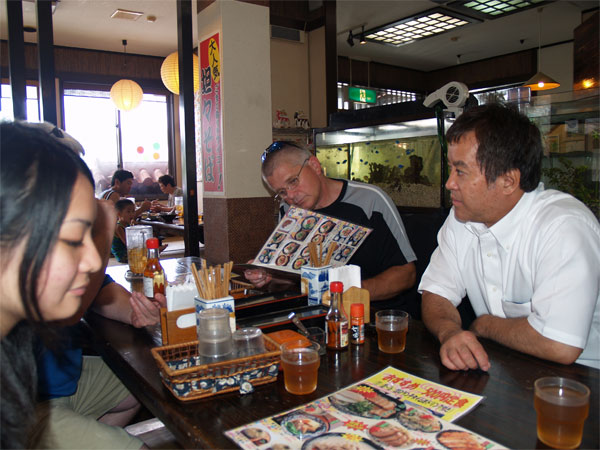 |
|
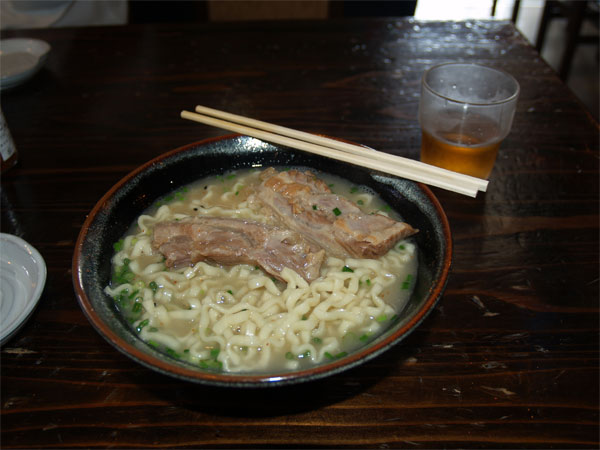 |
|
We drove by Nakamoto Sensei's Bunbukan dojo which we were in the process of setting up a tour. Sadly, Nakamoto Sensei's wife passed away and we felt very sorry for his loss.
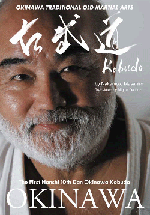
|
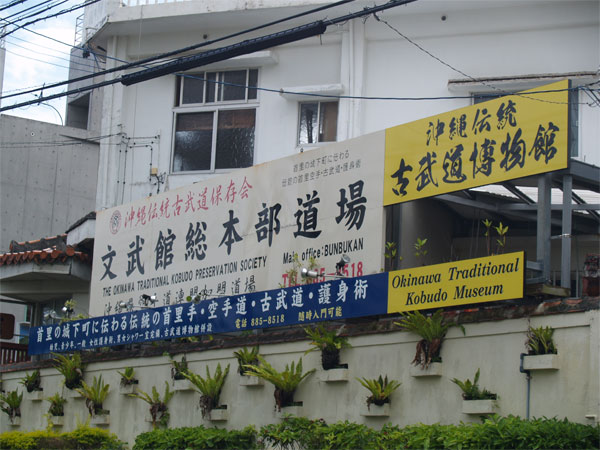 |
The rain started it's off/on behavior typical of this time of year and then the sun would come out and kill us with humidity. We returned to the hotel and walked around Gate 2 street to kill some jet lag and then returned for a quick nap before heading to the Hombu. BIG MISTAKE. The worst thing you can do while getting acclimated to Japan time in the first few days is take a nap when your body is normally in deep REM sleep back in the states. I woke up in "the land of the bunnies."
|
 |
|
We arrived at the dojo as the kids class was finishing up and the children were being coached on their kata performance for the upcoming Okinawa Times Youth Tournament.
The humidity was at it's typical high and we quickly got dressed out for the evening's keiko. We each turned and faced the rear mirrors in seiza until Gibu Sensei announced "Yoroshii" and gave us permission to bow in and begin warm ups.
|
 |
| With friendly indifference, our seniors came in, shook hands, gave us a smile and also began stretching before our training began. Keep in mind, just because you have flown across the pond doesn't mean anything.
The Butokukan is a spartan dojo.
Everyone is as friendly as Gibu Sensei but they take training seriously and don't stand around and chat. Fighting is full contact with or without protectors and training is full on. No matter what rank you are, everyone is training on the floor, no bystanders with their arms folded watching class and only your best is acceptable. If you are sore, tired or injured, no one is going to pay attention or ask you "what's wrong?" to make you feel better or give you a ticket for conditional effort and performance. Damatte keiko-shut up and train.
We started with sai kata, moved to tonfa and then kama and bo. Gibu Sensei bowed everyone out at the end of keiko and then we presented him gifts as well as the Butokukan members that we had brought over.
|
 |
|
|
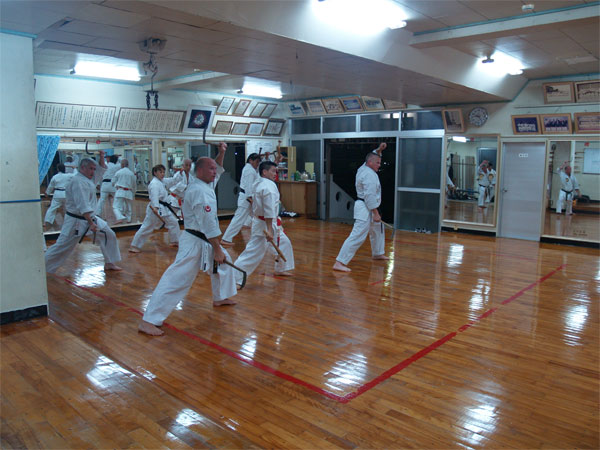 |
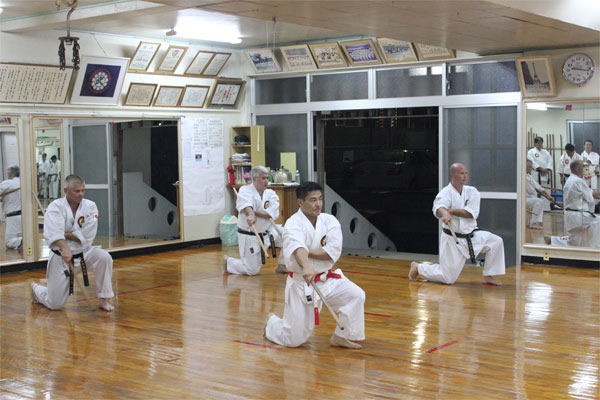 |
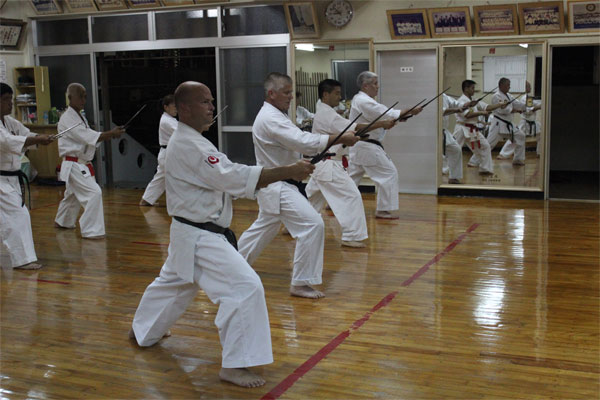 |
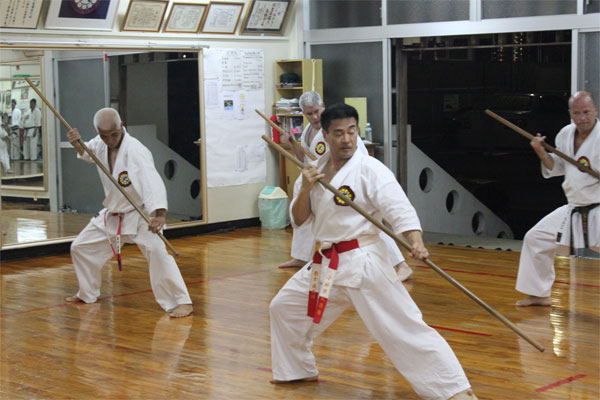 |
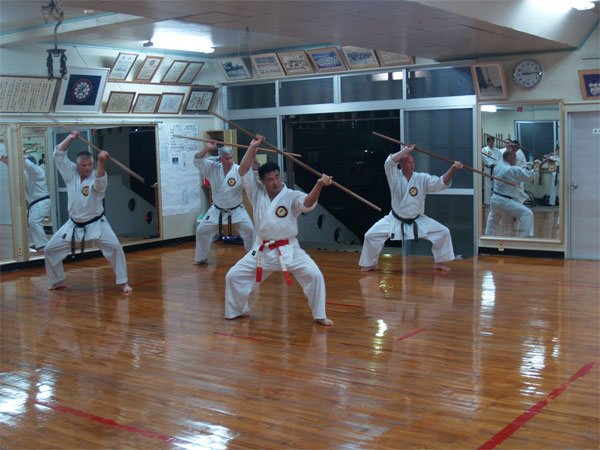 |
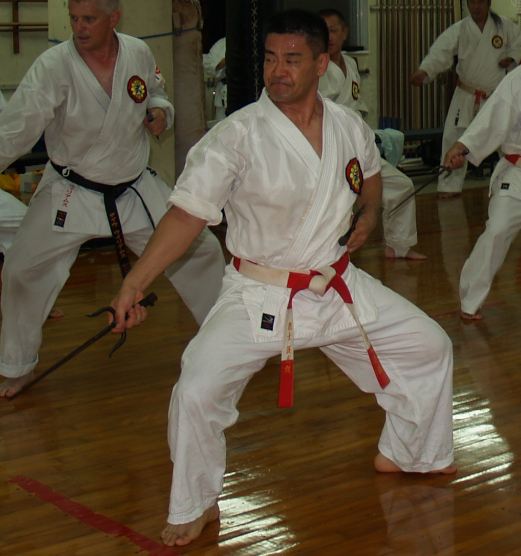 |
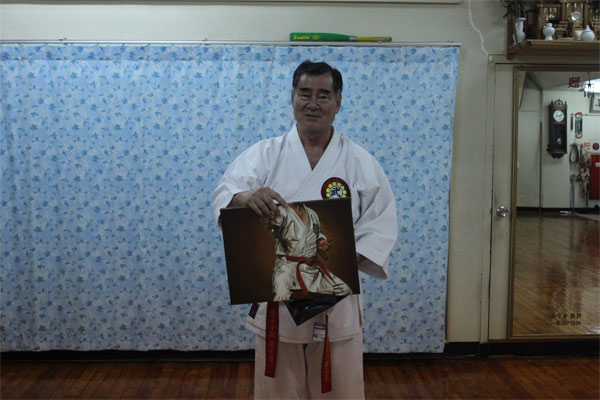
Lindsey Lord's oil painting of Gibu Sensei
|
Naka Sensei surprised me with a handcarved Eku he had made.
|
|
|
|
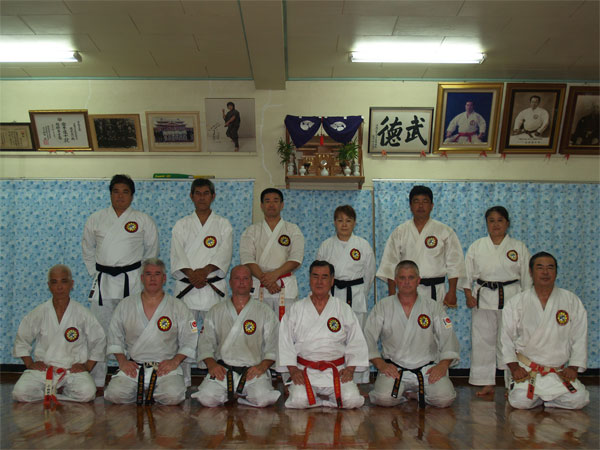 |
| Afterwards, Gibu Sensei treated everyone to a dinner at a restaurant around the corner from the Hombu dojo. We had more food than we could ever possibly eat and it was wonderful. We drove back to Koza and were able to stay awake to see another Fruit Bat flybay on the roof and tap into the Okinawa Survival stock in the fridge. The roof of the hotel is one of those reflective places where you can pinch yourself and realize that you are half a world away and actually in Okinawa. For most of us, training in Okinawa is dream and even after 10 times on the island, I still have to shake myself out of it and remind myself that I am so privileged to be there.
We returned to the hotel and headed up for our "team building" on the rooftop and reflected again on how happy we were to be in the birthplace of karate.
|
 |
|
Saturday July 9th
I couldn't sleep very solidly, maybe three hours tops. We must have the thinnest windows in the hotel because even on the third floor, you can hear everything outside on the street. The time change doesn't help but a trip to Okinawa is not a time to sleep in. Soak in every moment, no matter how simple.
We ate breakfast and then went to Izumi Sensei's house/dojo and watched him teach his new pre-school class. One of the students had Downs Syndrome and it was so inspiring to see Izumi Sensei's care towards this child-as if he were his own.
Shuun-kun was there helping him teach and it was neat to see how much he has grown in the past 6 years. He no longer was the small yellow belt that I had met years before but now a strong 3rd year chugakusei(middle school student) who just won the All Okinawa Kyokushinkai Full Contact division for his weight class in the Spring. Izumi Sensei's students are fighters. The young students are dangerously powerful and will cause damage to any full grown adult with their shin kicks.
In the Butokukan, everyone is a fighter, the Hombu dojo is known for it. Izumi Sensei has to lie to students sometimes and tell them that it is "fight night" in order to get them to come on a night were he wants to focus on kata only. Their kata is impressive as well but everyone fights, from white belt up.
|
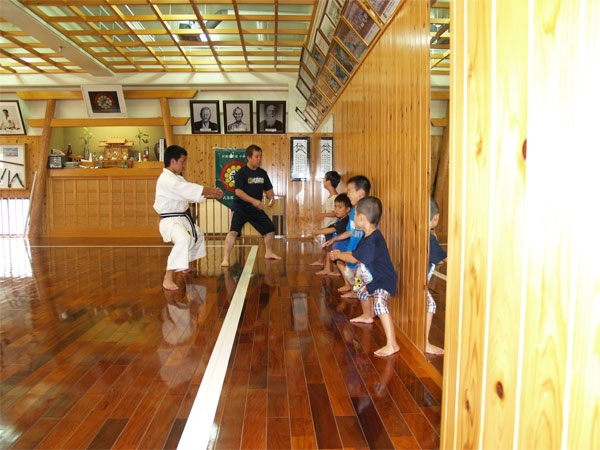 |
|
|
|
|
| We left the dojo and headed to Ginowan to meet with Tamaki Sensei and Sunagawa Sensei who were taking us on a day trip to Nanzan(Southern Kingdom) They first treated us to an all-you-can eat sushi bar right across from the Ginowan Convention Center and then we headed to Shureido very quickly so I could pick up my gi and get my Butokukan patch sewed on there at the store.
Interesting note with the patch. I asked Gibu Sensei if I could buy a patch from him for the new gi last night and after paying him for the patch with a little more money than required, he insisted on giving me change and even put it in money envelope. I was more than happy letting him keep the change but he was firm on giving me the $3 change. On Okinawa, sadly, there are some teachers that have sold out. They will charge outrageous prices for training, association dues, test anyone that comes to the island regardless of time in grade, age or experience. Yet here was my teacher insisting on giving me change for a gi patch. It is even in these small moments that I realize how fortunate I am.
But I digress. We met Tamaki Sensei and Sunagawa Sensei at the Okinawan Kenritsu Budokan where we left our rental car and piled in her van for the trip to Chinen.
|
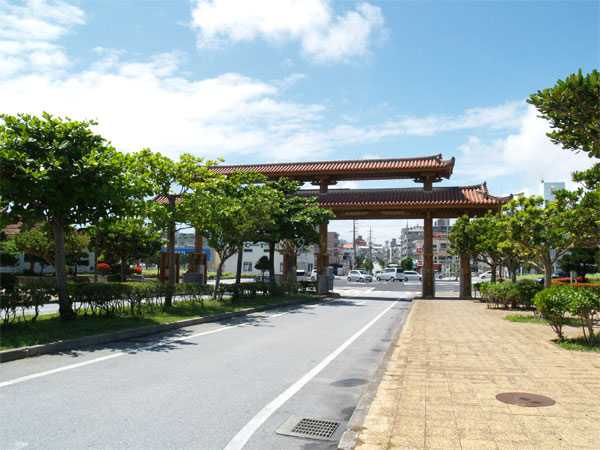 |
 |
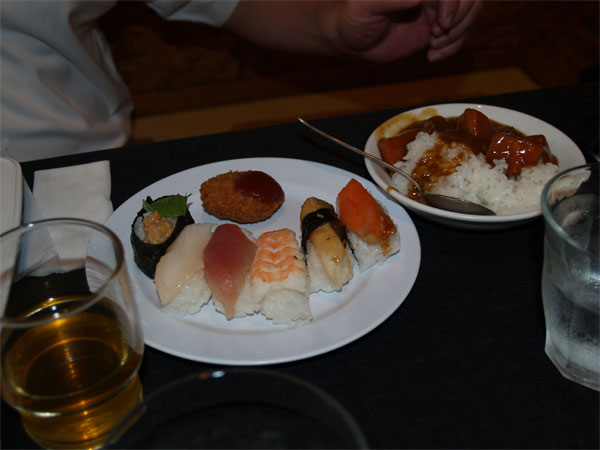 |
| Our first stop was Itokazu Gusuku, which I had never heard of before. It was the largest castle built in the Tamagusuku area and was ruled by the third son of Lord Tamagusuku. Tamaki Sensei told me that he was surprised that many people don't visit this even though it is listed as one of the World Heritage sites. It is interesting to see the actual coral that was used as "brickwork" for the castle and then the stones that were cut for the walls. There was plenty of vegetation around that served as a playground for many different varieties of butterflies and as Sunagawa Sensei warned habu(Okinawa's plentiful pit viper). |
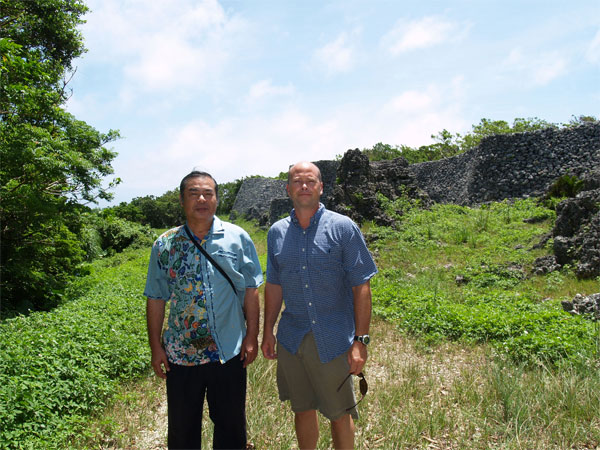 |
 |
 |
 |
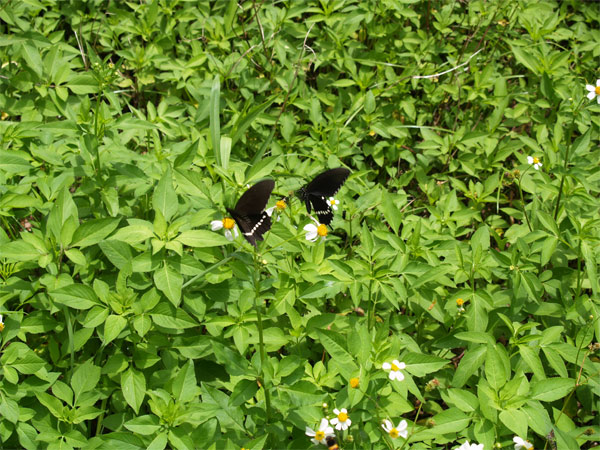 |
|

We stopped at the Mukashikan(rough translation: long ago house/hall) which was owned by a private collector of fossils of all types of prehistoric creatures.
|
 |
|
 |
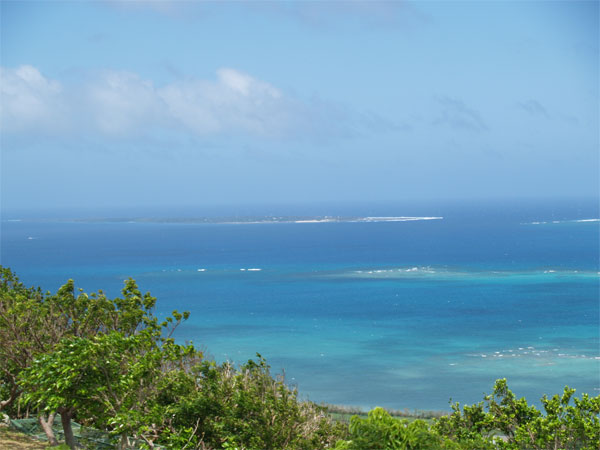
Kudaka Jima in the background
|
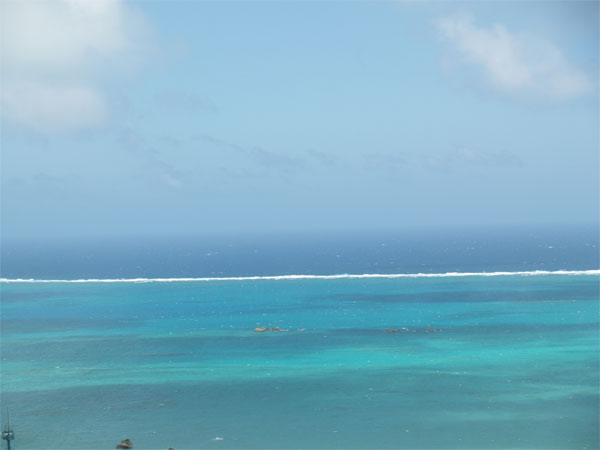 |
 |
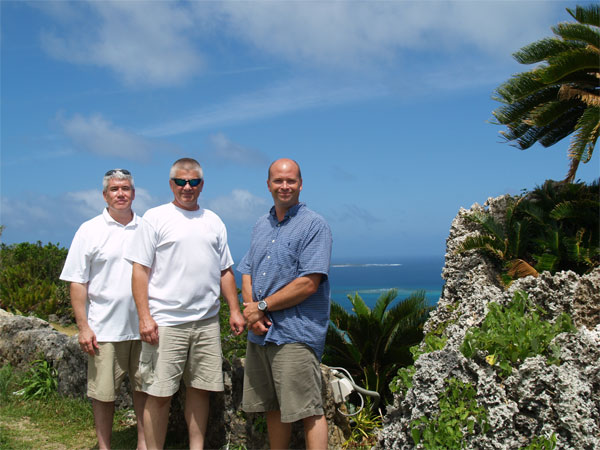 |
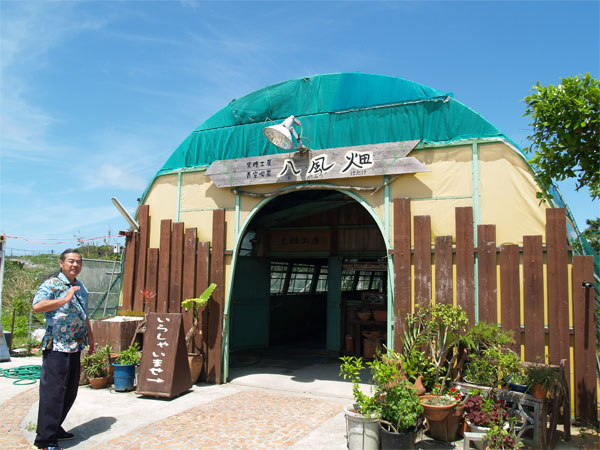 |
A local sugar factory
|
 |
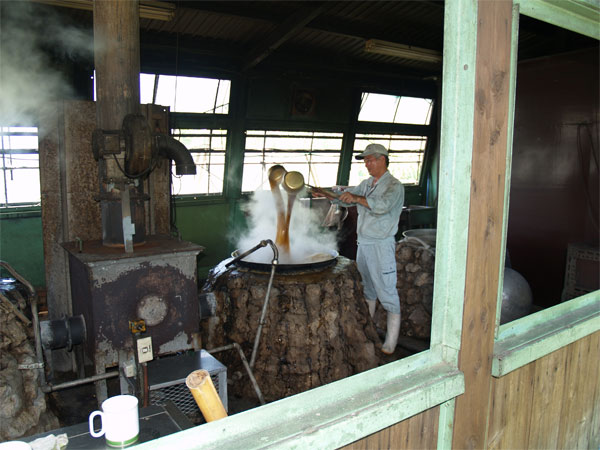 |
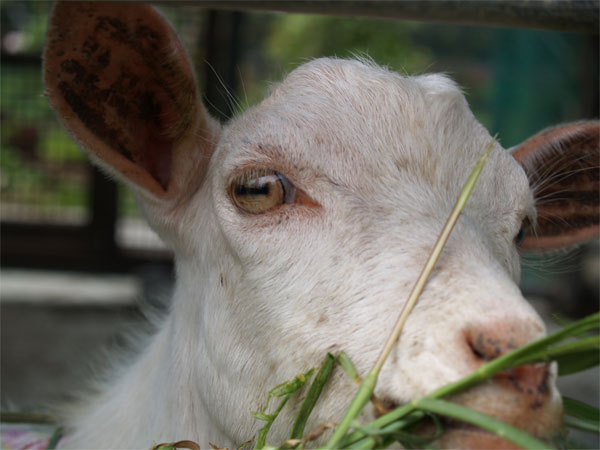 |

|

Kakinohana Hiijah (Spring)
|

|
|
|
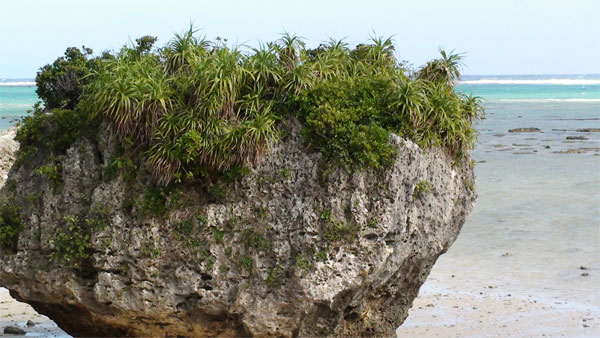 |
 |
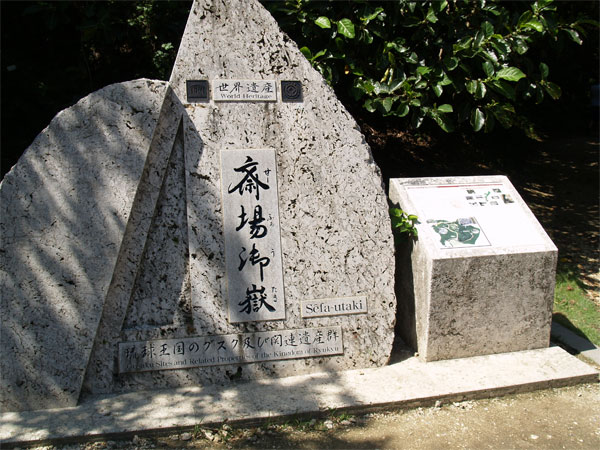 |
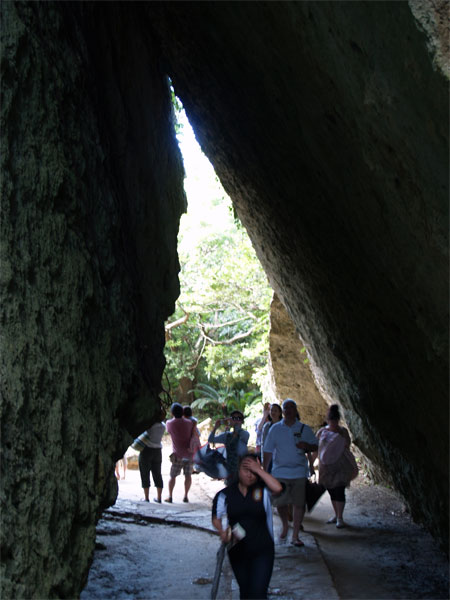
Sefa-Utaki
|
| We headed to the Butokukan to attend a referee meeting with the Butokukan members. Gibu Sensei, Ifuku Bentoku Sensei(Shorinkan) and I chatted together for a bit before we left for Koza. Joe and Dave followed in our rental car as I rode with Izumi Sensei in his father's pickup. Fatigue and jet lag really was killing us by now, not to mention the climbing we had done on our wonderful trip with Tamaki Sensei and Sunagawa Sensei.
We got changed and headed to a great izakaya with Izumi Sensei for a meal of horse sashimi, rafute, scallops, gurukun fried fish, sashimi fish, fried tebichi(pigs feet) , and sashimi/veggie appetizer. What a great meal. The rafute was especially delicious and I already started trying to brainstorm where I could get pork belly from once I got home. We had a great time with a lot of laughter and full stomachs. I don't think any of us had problems sleeping.
|
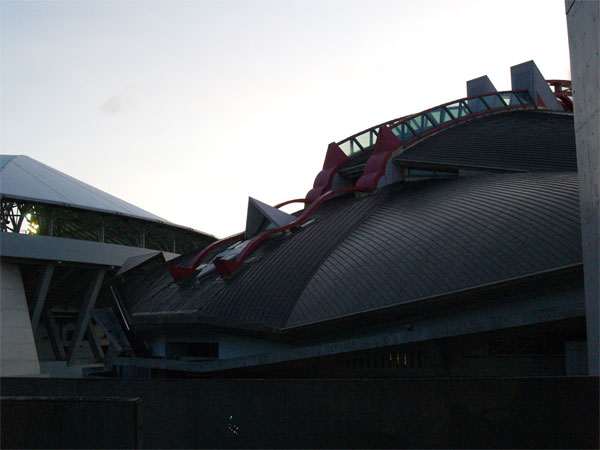 |
 |
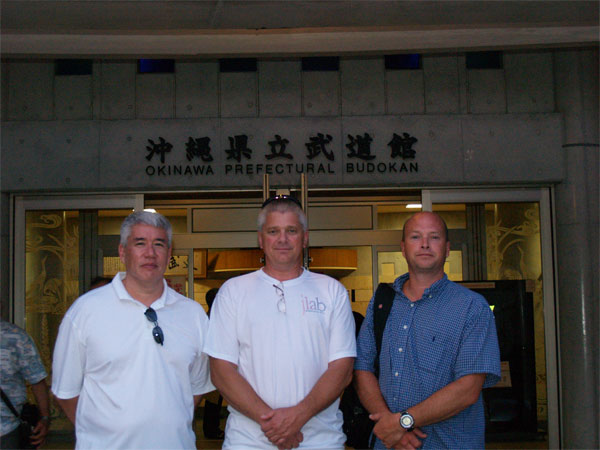 |
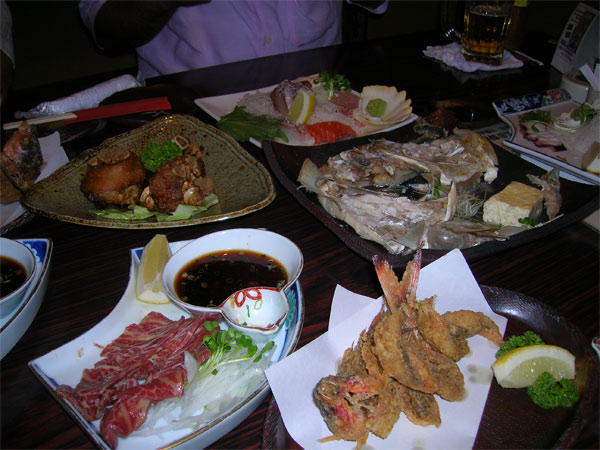 |
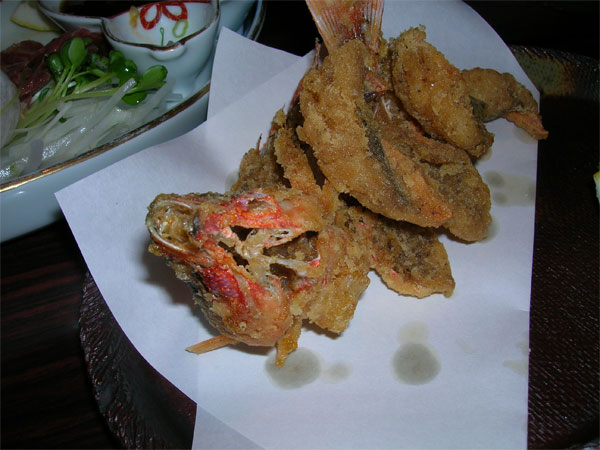 |
|
|
|
Monday July 11th
We woke up and headed to Izumi Sensei's dojo for morning training. It is amazing how hot and humid his dojo becomes, even at 10 in the morning. We ran through kata and then spent the rest of the session doing kigu undo/hojo undo like kids in a candy store. Izumi Sensei has one of the most beautiful and well-equipped dojos I have ever seen.
|
 |
 |
 |
 |
 |
 |
|
|
|
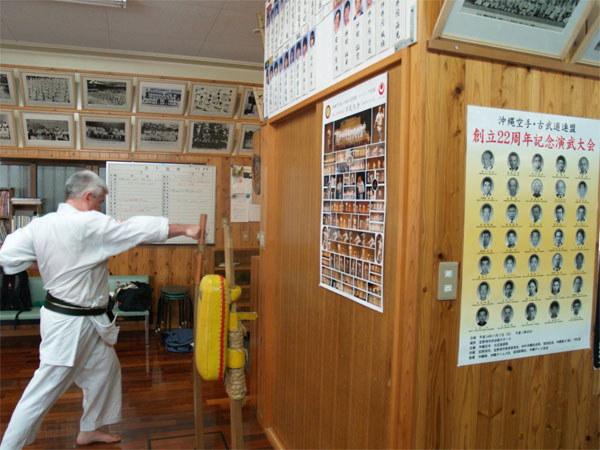 |
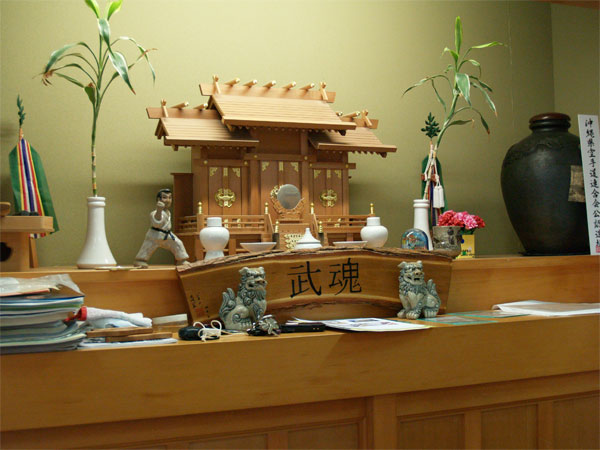 |
 |
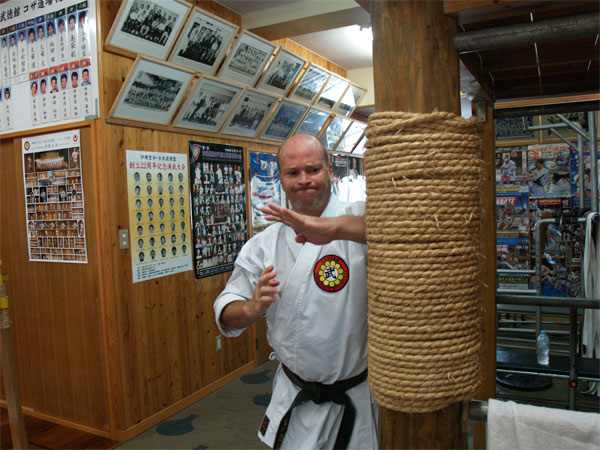 |
 |
|
|
After washing gis, we ran down to Shureido since Dave had one more order to place and we saw Oshiro Toshihiro, Hanshi/Kudan Shorin-Ryu, come in a chat with Nakasone san.
Dave wanted to get some shopping in for his wife and family so we headed for Kokusai dori and after some browsing, headed for Makishi Market for some lunch. The market has restaurants on the second floor with standard Okinawan fare but you can also purchase seafood and pork from the market downstairs and have it cooked for you at one of the restaurants on the second floor.
|
|
 |

Ika-sumi (squid ink soup)
|
 |
 |
| We figured that since we were near Urasoe, we would kill time instead of heading back to the hotel before training. We set out on a quest to find Urasoe Beach which is unknown even to some of the residents of the city. It took us a while to find Camp Kinser Gate 4, as it is tucked off of 58 behind the Municipal Building and local government offices. Once we found the gate, we just followed the fenceline until we found a place to park and got out to explore. The beach is in danger of destruction due to development in the area and provides residents with clear water, coral and at low tide, plenty of sea life to encounter. We stayed and watched a beautiful sunset with a few Okinawans that seemed to enjoy coming out to this place often. |
 |
|
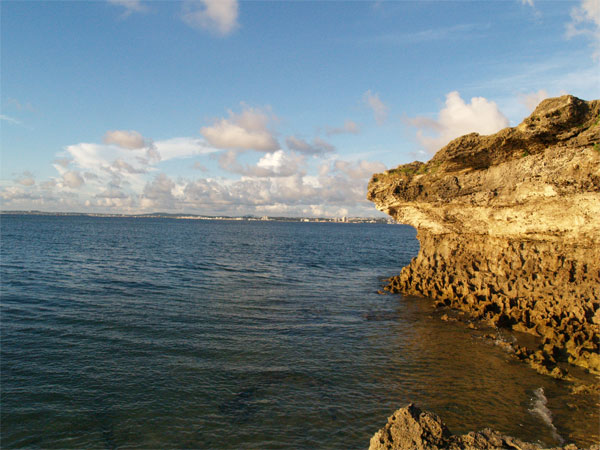 |
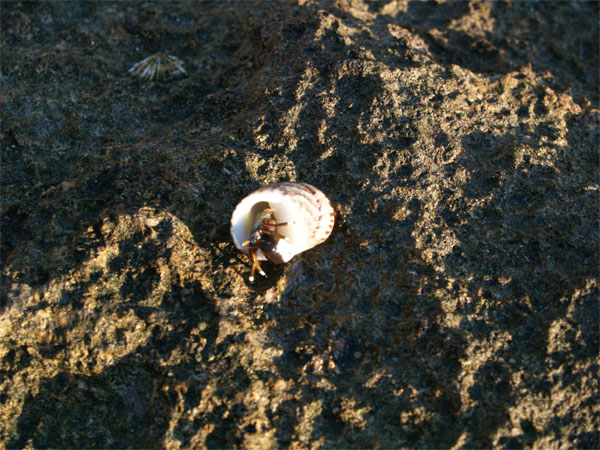 |
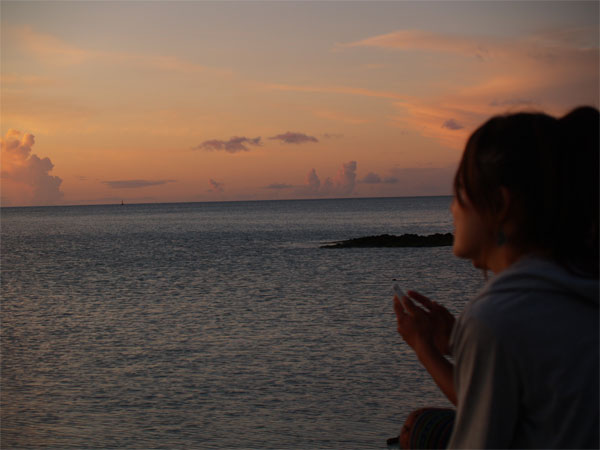 |
|
|
|
We arrived at the dojo just as kids class was ending and got dressed out. It was great to see so many of the yudansha coming out to train despite their busy schedules. The dojo was oozing humidity and Gibu Sensei wasted no time in getting us moving with dantai tsuki geri, which is hundreds of kicks, punches and blocks followed by kihon kata and fukyugata. These "kata" are used as junbi undo or warm ups in the dojo. All students begin kata instruction with naihanchi shodan as white belts.
|
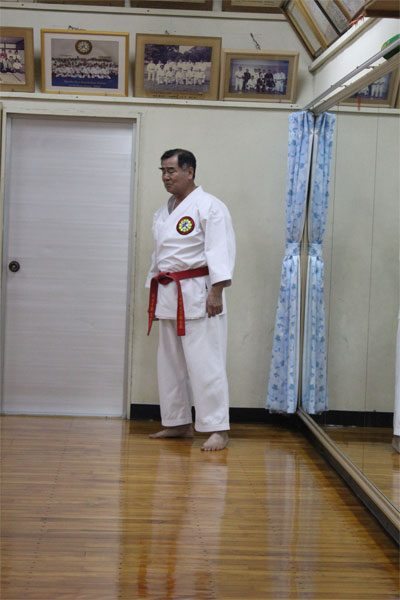 |
|
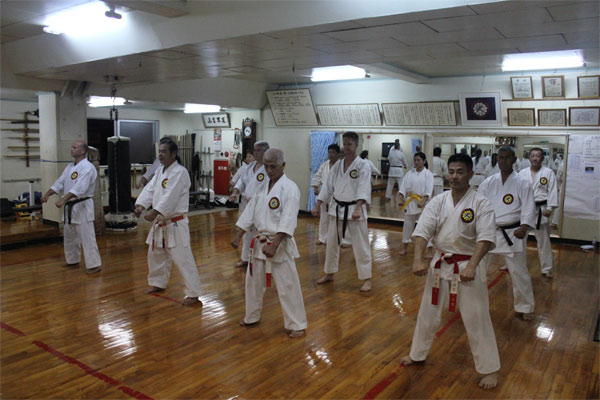 |
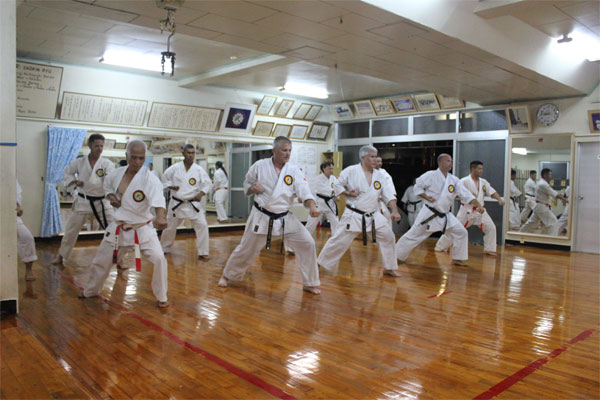
Fukyukata ichi
|
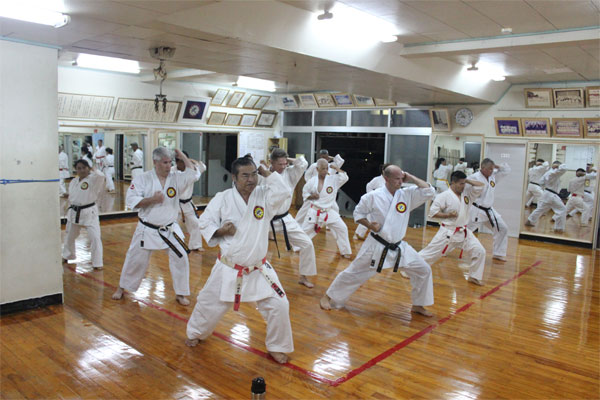
Fukyukata ni (gekisai)
|
| Dave had given everyone in the dojo a pair of his beautiful wooden tekko on Friday and Tamaki Sensei and others asked him to sign them. While he was doing this, Naka Sensei came up behind him and presented him with his personal metal tekko. These were not your typical Shureido tekko, these were hand crafted and amazing. Naka Sensei and Dave ran through Maezato no Tekko together to christen the gift and Dave's face had an expression that I will never forget.
When we had a moment, I pulled Naka Sensei aside and talked about kumite a bit. I asked him. "If you had to retire from karate completely tomorrow, what waza would you think are the most important in your kumite- for us to practice?"
This line of questioning is important. Most teachers and seniors on Okinawa very quickly dismiss our Western way of asking questions because we are so direct. With all of the yahoos that come to Okinawa, people will ask for about anything. "Where can I get that " "Will you teach me this" "Could I test for this?" So because Okinawan cultural protocol is very sensitive to direct questions, if you want an answer, you have to be careful how you phrase things.
Naka Sensei's physical answers were direct, painful and typical of his amazing fighting abilities. But they were sophisticated. It was first posture and then the way the opponent's body responded when it was hit a certain way. There was tiny details in "how you hit" not just hitting the area that you are trying to injure. Now, it also helps that Naka Sensei's weapons are hardened daily with everything from makiwara, shin bag to the hammer he hits his shins while he eats his lunch each day.
I sometimes think I have seen some amazing things but when Dave, Joe and I watched Naka Sensei at the makiwara, I hadn't seen this. Naka Sensei started out shin-kicking the face of the makiwara towards the base and then started POUNDING the side edge/point/corner of the board with his shins. I don't know how this didn't cut his skin but the man is incredible. The words that we all wanted to say out loud are not allowed in the dojo-or church.
|
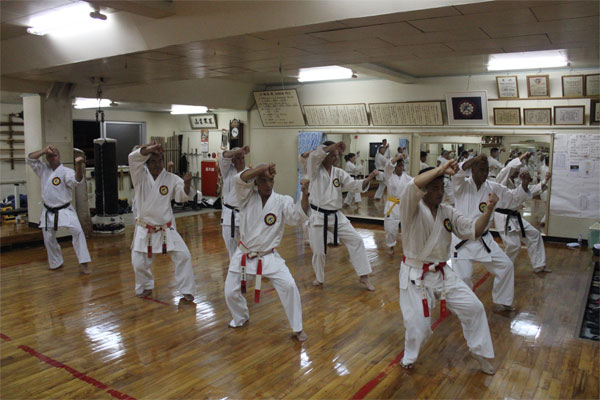
Pinan Shodan
|
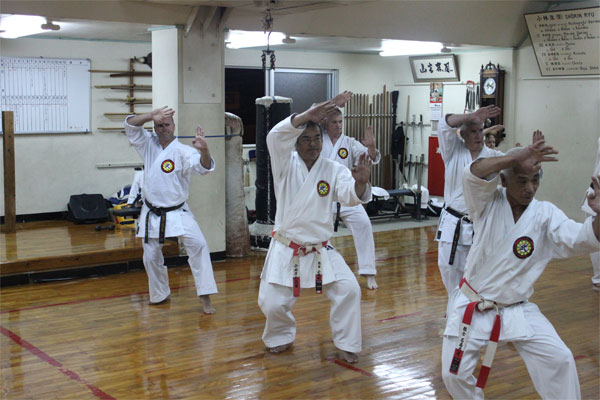
Pinan Yondan
|
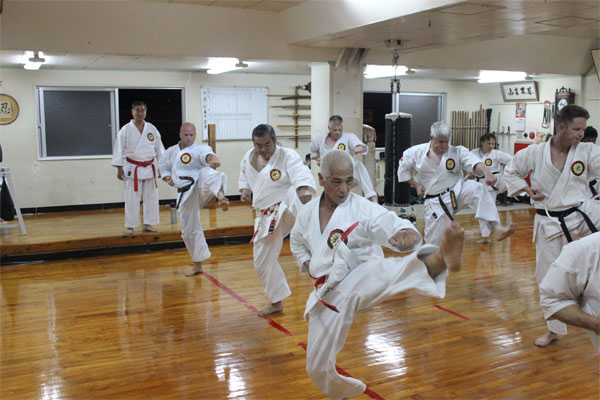 |
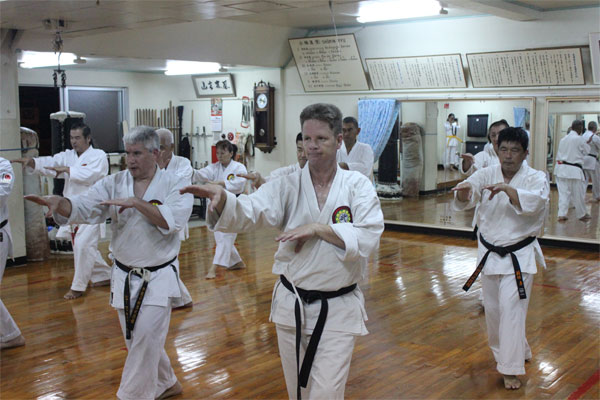 |
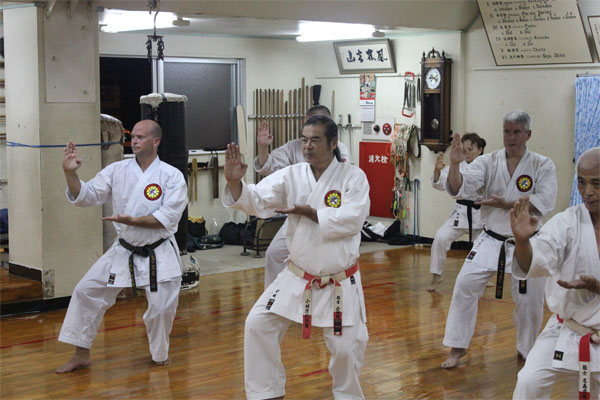 |
 |
 |
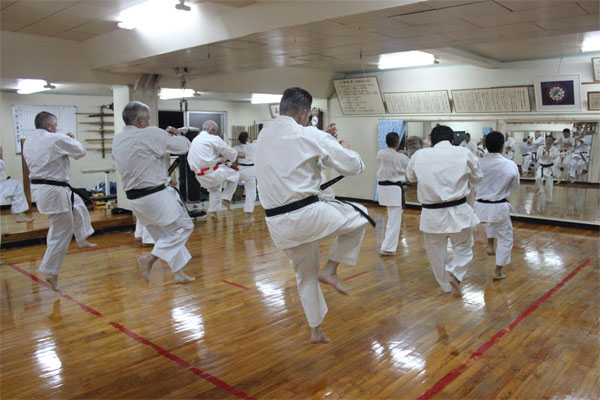 |
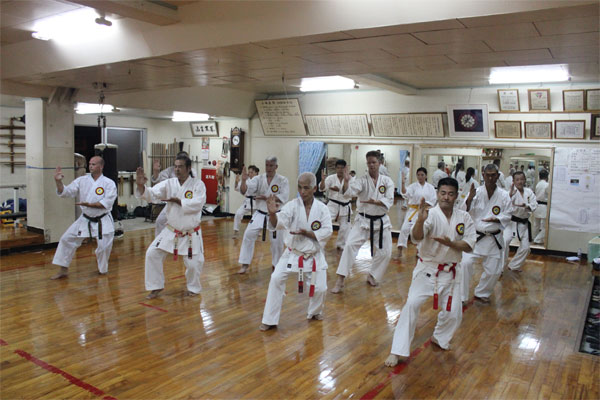 |
| We stopped an A &W fast food place and had a quick dinner before heading back to the hotel. Probably not the best thing to eat during the transition but we were exhausted and wanted to eat fast so we could pass out. |
|
|
|
|
|
 Go to Page 2 Go to Page 2
|

